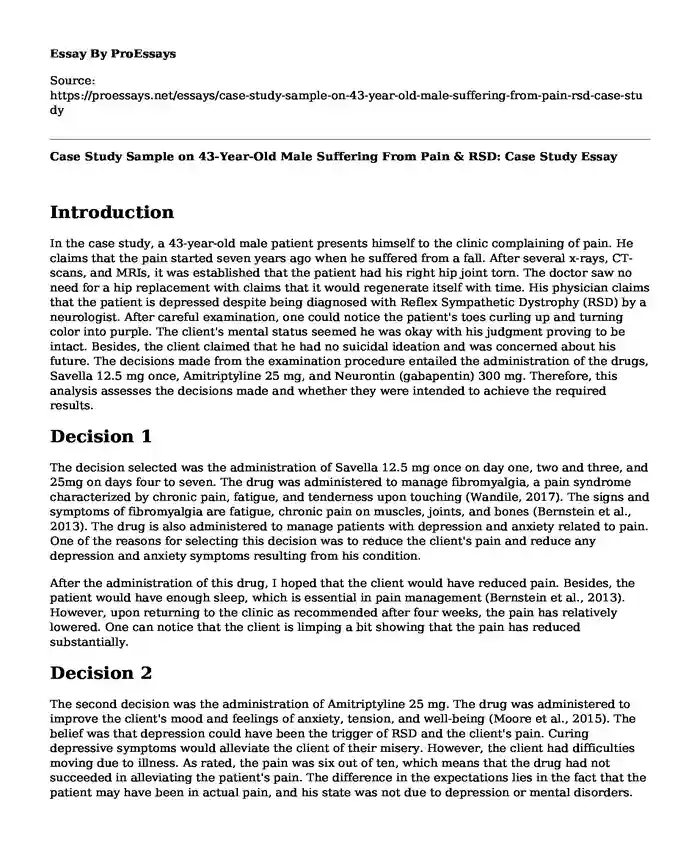Introduction
In the case study, a 43-year-old male patient presents himself to the clinic complaining of pain. He claims that the pain started seven years ago when he suffered from a fall. After several x-rays, CT-scans, and MRIs, it was established that the patient had his right hip joint torn. The doctor saw no need for a hip replacement with claims that it would regenerate itself with time. His physician claims that the patient is depressed despite being diagnosed with Reflex Sympathetic Dystrophy (RSD) by a neurologist. After careful examination, one could notice the patient's toes curling up and turning color into purple. The client's mental status seemed he was okay with his judgment proving to be intact. Besides, the client claimed that he had no suicidal ideation and was concerned about his future. The decisions made from the examination procedure entailed the administration of the drugs, Savella 12.5 mg once, Amitriptyline 25 mg, and Neurontin (gabapentin) 300 mg. Therefore, this analysis assesses the decisions made and whether they were intended to achieve the required results.
Decision 1
The decision selected was the administration of Savella 12.5 mg once on day one, two and three, and 25mg on days four to seven. The drug was administered to manage fibromyalgia, a pain syndrome characterized by chronic pain, fatigue, and tenderness upon touching (Wandile, 2017). The signs and symptoms of fibromyalgia are fatigue, chronic pain on muscles, joints, and bones (Bernstein et al., 2013). The drug is also administered to manage patients with depression and anxiety related to pain. One of the reasons for selecting this decision was to reduce the client's pain and reduce any depression and anxiety symptoms resulting from his condition.
After the administration of this drug, I hoped that the client would have reduced pain. Besides, the patient would have enough sleep, which is essential in pain management (Bernstein et al., 2013). However, upon returning to the clinic as recommended after four weeks, the pain has relatively lowered. One can notice that the client is limping a bit showing that the pain has reduced substantially.
Decision 2
The second decision was the administration of Amitriptyline 25 mg. The drug was administered to improve the client's mood and feelings of anxiety, tension, and well-being (Moore et al., 2015). The belief was that depression could have been the trigger of RSD and the client's pain. Curing depressive symptoms would alleviate the client of their misery. However, the client had difficulties moving due to illness. As rated, the pain was six out of ten, which means that the drug had not succeeded in alleviating the patient's pain. The difference in the expectations lies in the fact that the patient may have been in actual pain, and his state was not due to depression or mental disorders.
Decision 3
The final decision made was on the administration of Neurontin (gabapentin) 300 mg. the drug was administered to treat chemicals and nerves in the body that cause pain and seizures and pain associated with psychiatric disorders (Berlin et al., 2015). The thought was that the client's hip pain resulted from nerve pain. However, the drug was not effective in alleviating the patient's pain. The reason behind the medicine's ineffectiveness is because nerves and body chemicals may not have caused the pain.
Conclusion
From the analysis of the decisions undertaken, Savella's prescription in decision one remained the most appropriate technique. The drug considerably reduced the patient's pain. The patient had fibromyalgia explaining why Salvella drug alleviated him of his illness. Other prescriptions, such as Amitriptyline and Neurontin, were not as valid as Savella. From this, one can see the effectiveness of decision analysis in determining the most appropriate decision undertaken.
References
Berlin, R. K., Butler, P. M., & Perloff, M. D. (2015). Gabapentin therapy in psychiatric disorders. The Primary Care Companion for CNS Disorders.
https://doi.org/10.4088/pcc.15r01821
Bernstein, C. D., Albrecht, K. L., & Marcus, D. A. (2013). Milnacipran for fibromyalgia: A useful addition to the treatment armamentarium. Expert Opinion on Pharmacotherapy, 14(7), 905–916. https://doi.org/10.1517/14656566.2013.779670
Moore, R. A., Derry, S., Aldington, D., Cole, P., & Wiffen, P. J. (2015). Amitriptyline for neuropathic pain in adults. Cochrane Database of Systematic Reviews.
https://doi.org/10.1002/14651858.cd008242.pub3
Wandile, P. (2017). Fibromyalgia management with homeopathy. Homœopathic Links, 30(04), 245–249. https://doi.org/10.1055/s-0037-1608614
Cite this page
Case Study Sample on 43-Year-Old Male Suffering From Pain & RSD: Case Study. (2023, Oct 14). Retrieved from https://proessays.net/essays/case-study-sample-on-43-year-old-male-suffering-from-pain-rsd-case-study
If you are the original author of this essay and no longer wish to have it published on the ProEssays website, please click below to request its removal:
- Antibiotics: Definition, Types, and Brief History
- Course Work on Public Health: Education and Community-based Programs
- Intuitive Eating Essay
- Essay Sample on Nutritional Supplement
- Essay on Myelodysplastic Syndrome: Changes in Mechanical, Physical & Biochemical Function
- Essay Example on High-Performance Team Leadership in Nursing Environment
- Essay Example on Nurse Burnout: Effects on Patient Outcomes







